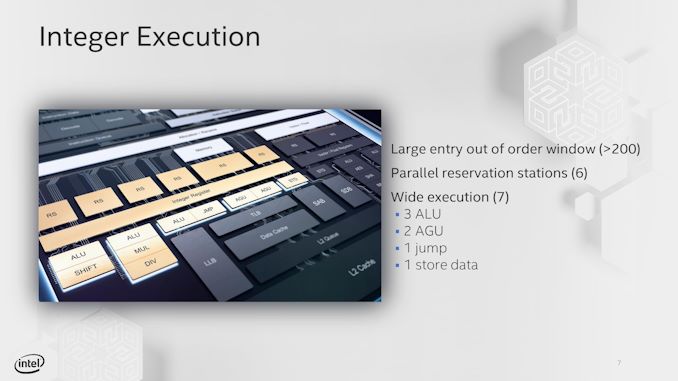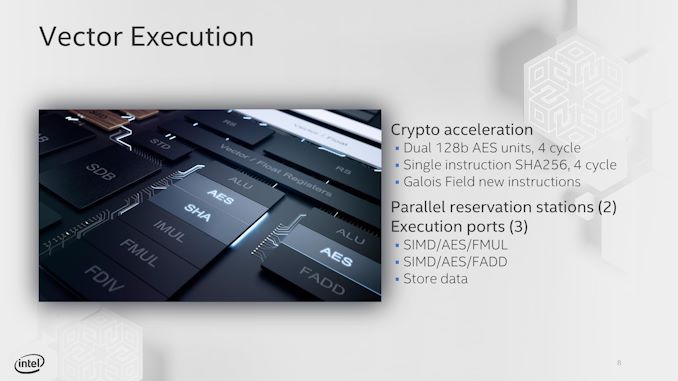Intel's new Atom Microarchitecture: The Tremont Core in Lakefield
by Dr. Ian Cutress on October 24, 2019 1:30 PM ESTA Wider Back End
Moving beyond the micro-op queue, Tremont has an 8 execution ports, filled from 7 reservation stations.
The only two ports using a combined reservation station are the address generator units (AGUs) - this is in stark contrast to the Core design, which in Sunny Cove uses a unified reservation for all integer and floating point calculations and three for the AGUs. The reason that Tremont uses a unified reservation station for the two AGUs, also backed by extra memory for queued micro-ops, is in order to supply both AGUs with either 2x 16-byte stores, 2x 16-byte loads, or one of each. Intel clearly expects the AGUs on Tremont to be fairly active compared to other execution ports.
On the integer side, aside from the two AGUs, Tremont has 3 ALUs, a jump port, and a store data port. Each ALU supports different functions, with one enabling shift functions and another for multiplication and division. Compared to core, these ALUs are extremely lightweight, and Intel hasn’t gone into specifics here.
On the floating point side, we are a little bit more varied – the three ports are split between two ALUs and a store port. The two ALUs have one focused on fused additions (FADD), while the other focuses on fused multiplication and division (FMUL). Both ALUs support 128-bit SIMD and 128-bit AES instructions with a 4-cycle latency, as well as single instruction SHA256 at 4-cycles. There is no 256-bit vector support here. In order to help with certain calculations, GFNI instruction support is included.
There is also a larger 1024-entry L2 TLB, supporting 1024x 4K entries, 32x 2M entries, or 8x 1G entries. This is an upgrade from the 512-entry L2 TLB in Goldmont.
New Instructions
As with any generation, Intel adds new supported instructions to either accelerate common calculations that would traditionally require lots of instructions or to add new functionality. Tremont is no different.
| TITLE | |||||
| AnandTech | Tremont | Goldmont Plus |
Goldmont | Airmont | Silvermont |
| Process | 10+ | 14 | 14 | 14 | 22 |
| Release Year | 2019 | 2017 | 2016 | 2015 | 2013 |
| New Instructions | CLWB GFNI ENCLV CLDEMOTE MOVDIR* TPAUSE UMONITOR UWAIT |
SGX1 UMIP PTWRITE RDPID |
RDSEED SMAP MPX XSAVEC XSAVES CLFLUSHOPT SHA |
SSE4.1 SSE4.2 MOVBE CRC32 POPCNT CLMUL AES RDRAND PREFETCHW |
|
(When asked what other new instructions are supported, Intel stated to look at the published documents about future instructions. When it was pointed out that those documents weren’t exactly clear and that in the past Intel hasn’t spoken about future designs, we were not afforded additional comments.)
When we get hold of a Tremont device, we’ll do a full instruction breakdown.












101 Comments
View All Comments
Valantar - Friday, October 25, 2019 - link
Intel doesn't use the Atom name any longer, at least not officially. Is it anywhere in this slide deck? As for Pentium/Celeron, P/C Silver is Atom-based, Gold is Core, and that applies even to the newest product stack (Intel even launched updated Goldmont Plus Gemini Lake Pentium/Celeron chips just a few days ago, topping out with the J5040 and N5030: https://www.techpowerup.com/260374/intel-gemini-la... Confusing? Absolutely. But nothing has changed since the (admittedly stupid) gold/silver branding was introduced.levizx - Sunday, October 27, 2019 - link
Maybe get your eyes checked? This while article is about the Tremont uArch, so are the slides.Gemini Lake is old news, doesn't matter what "new" product Intel releases. Intel had Atom on their roadmap as late as last December.
BUT, their May investor meeting failed to disclose what brands Lakefield will be under. So as far as the general public know. Atom is still alive in ultra low-power Server SoC and embedded SoC space.
eddman - Sunday, October 27, 2019 - link
There hasn't been an atom branded mainstream (desktop, laptop or tablet) processor strarting with goldmont; only server, embedded and automotive parts, and starting with goldmont plus there is none whatsoever.eddman - Sunday, October 27, 2019 - link
*No edit function*What I meant to say is, while atom branding is not dead, intel has moved away from using it for the products facing the mainstream consumers. It's all pentium and celeron.
I doubt they'd bring it back for lakefield, which even uses a single "big" sunny cove core.
eek2121 - Monday, October 28, 2019 - link
Not true, Apollo Lake showed up in an SBC form factor. That is goldmont + gen9 iGPU.eek2121 - Monday, October 28, 2019 - link
Gah anandtech needs to join the year 2000 and add an edit button. The atom CPU I have seen used is the atom e3900. Yes it is technically an embedded part, but it is also used by consumers for various projects, including home theater applications and the like.eddman - Monday, October 28, 2019 - link
Such devices are not mainstream.Namisecond - Friday, November 1, 2019 - link
You're talking the uarch. The person you're talking to is talking about the Atom brand name.rrinker - Thursday, October 24, 2019 - link
Depends on what you use them for. I have a box I built at least 7 years ago, so whatever Atom was current - I think it was the first one to have 2 cores. I ran Linux on it, mostly for controlling my model railroad. It was plenty fast enough, even with a slow hard drive and just 2GB RAM. I couldn't stream video to it, but music was fine, and it ran both the control program as well as a 2D CAD program to design track plans.Not every task a computer does requires insane speeds. There's a whole lot more than just gaming.
1_rick - Thursday, October 24, 2019 - link
They're good enough for things like NASes.